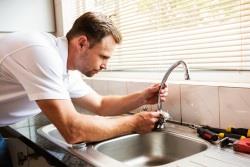Save on Your Water Bill
Category Property Maintenance & Costs
Although plumbing may not seem like a fun and rewarding project, you can avoid a lot of problems with some basic DIY skills and knowledge of how your home water system and plumbing works.
 Having the stopcock easily accessible also allows you to check for leaks. While it's easy to see leaks inside a house or in the garden, if a stopcock is buried and not visible you could have a leak without even knowing it.
Having the stopcock easily accessible also allows you to check for leaks. While it's easy to see leaks inside a house or in the garden, if a stopcock is buried and not visible you could have a leak without even knowing it.Water leaks can be frustrating and tough on the wallet. Luckily, many household leaks can be fixed relatively easily.
However, before you consider fixing a leak yourself, you need to determine where the leak is, and how to stop the water from flowing to the area.
One thing that every homeowner needs to know is where the main stopcock for the water on their property is.
Get tips…
Location of stopcock
A stopcock controls the water flow from municipal supply onto a residential property.
It's the first place you go to if there is an emergency and you need to switch off the main water supply to your home. If you don't know the location of the stopcock, you could end up with a flooded home and expensive damage.
Since stopcocks are installed on the main water supply line to a property, these are generally in the ground and can be covered by soil and plants, making it difficult to locate and turn off in an emergency. If you know where your stopcock is, ensure it is easy to get to should you need to turn off the water supply.
 If you suspect a water leak in the underground pipes, first take a meter reading from the municipal water meter.
If you suspect a water leak in the underground pipes, first take a meter reading from the municipal water meter.It's also important to ensure that the stopcock mechanism itself is in working order and that the tap hasn't locked up, which could be the case if it has never been used or has been buried in the ground.
Having the stopcock easily accessible also allows you to check for leaks. While it's easy to see leaks inside a house or in the garden, if a stopcock is buried and not visible you could have a leak without even knowing it.
If you suspect a leak due to rising water costs, have a look around the water pipes for mould and algae growth or excess ground water in the soil. These can be an indication that there is underground water.
Test for underground leaks
If you suspect a water leak in the underground pipes, first take a meter reading from the municipal water meter.
Stop using water for at least an hour while doing this test.
 Water leaks can be frustrating and tough on the wallet. Luckily, many household leaks can be fixed relatively easily.
Water leaks can be frustrating and tough on the wallet. Luckily, many household leaks can be fixed relatively easily.After one hour, take another meter reading and compare this to the original reading. This will tell you how much water is leaking every hour.
Good to know
Older municipal water meters were fitted with a stopcock to turn off municipal water supply outside a residential property.
Newer meters no longer have a stopcock. If a leak occurs between the municipal meter and your residential stopcock, or if you don’t have a stopcock to turn off your residential water supply, you’ll need to make arrangements with the local municipality to fit one. This can cost anywhere from R800 to R1 500.
Article courtesy of Home-Dzine
Author: Home- Dzine




